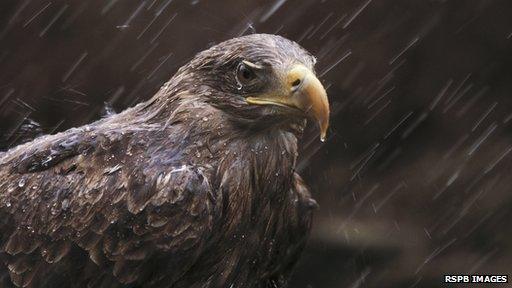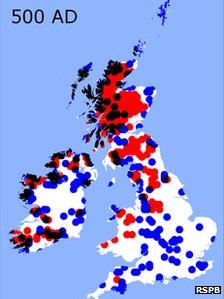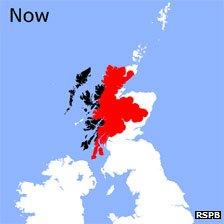Golden and sea eagle decline since Dark Ages mapped
- Published

White-tailed sea eagles were extinct in Britain and Ireland by the early 20th Century
The decline in numbers of golden and white-tailed sea eagles in Britain and Ireland since the time of King Arthur has been mapped by the RSPB.
Researchers looked at places named after eagles in Gaelic and Old English to help estimate populations of the birds in AD500.
From the Dark Ages, they drew on historical material and studies to map pairs of the raptors to the present.
The RSPB said the maps painted "a sad picture of decline".
Published in Bird Study, the journal of the British Trust for Ornithology, the study suggests both species were once found across lowland and upland Britain and Ireland.
There were an estimated 1,000 to 1,500 pairs of golden eagles in AD500, when <link> <caption>Arthur</caption> <altText>Link to BBC essay on Arthur</altText> <url href="http://www.bbc.co.uk/history/ancient/anglo_saxons/arthur_01.shtml" platform="highweb"/> </link> was said to have been a mythical king, or a real-life warlord.

Golden eagle range in red, sea eagle in blue and shared air space in black
By the year 1800, by which time the Industrial Revolution was in full swing, numbers of the eagles had fallen to as few as 300.
According to the RSPB, up to 90% of sea eagles were lost over that same period and the species was extinct in Britain by the early years of the 20th Century.
Human persecution and the destruction of habitats have been blamed for the falling numbers.
White-tailed sea eagles were reintroduced to the Isle of Rum, off Scotland's west coast, in 1975, followed by other programmes to bring back the birds to other parts of Scotland.
Thirty-one pairs of sea eagles and 440 golden eagles were recorded in 2003.
Richard Evans, of RSPB Scotland and lead author of the study, said the results were striking.
He said: "They provide compelling evidence that eagles were widespread throughout most of Britain and Ireland in the Dark Ages.
"Between 500 and 1800 we see massive loss of eagle range in the south, which is consistent with the effects of habitat loss and killing by humans, rather than the influence of climate change on habitat, or competitive exclusion, as some have suggested.

The eagles' ranges are limited to Scotland today
"This trend continued in the years up to the First World War, until the only eagles left in all of Britain and Ireland were golden eagles in the highest hills and deer forests of Scotland."
Mr Evans added: "Recovery of golden eagles since this low point has now stalled, while limited recovery of white-tailed eagles has only been possible by reintroduction.
"Although the reintroduced white-tailed eagle population is healthy, at present they occupy only a fraction of their former range."
The study drew on research of names representing the word "eagle" given to places when Old English, Norse, Welsh and Scots and Irish Gaelic that replaced older Celtic language place names.
In Scots Gaelic, 276 such place names were found, 152 in Old English, 84 in English, 66 in Scots, 63 in Irish Gaelic, 55 in Norse, 18 in Welsh and two in Manx.
The method has been used to estimate numbers of other species.
- Published14 March 2012
- Published13 December 2011
- Published2 September 2011
- Published13 August 2011